May 26 – June 2, 2023

Friday, May 26th was a travel day from Valencia, Spain to Lyon, France on Volotea Airlines. It was a pleasant and easy hour & a half flight. Volotea is another budget airline company which connects cities all over Europe. My amazing French cousins, Astrig and Claudine met me at the airport.

We had dinner at Chez M’man, a “Bouchon” in the Bellecour district. A “Bouchon” is a type of restaurant found in Lyon that serves traditional Lyonnaise cuisine, so it was fun to eat regional food at a family-run eatery. After supper, we went to Claudine and Astrig’s choir rehearsal.

My cousins are members of a very active Gomidas Choir which performs all over southern France. The group is named after the late 19th century Armenian priest and musicologist who collected thousands of pieces of ancient Armenian folk and religious songs.

Claudine and Astrig live in Chasse-sur-Rhone which is a small village just outside the Roman town of Vienne, about 20 miles south of Lyon, France. Vienne was a major urban center of the Roman Empire. Today, there are still many Roman artifacts all over Vienne and the surrounding area.

In the center of Vienne there is an original ancient Roman Temple. It was built at the beginning of the 1st century to honor the Emperor Augustus and his wife Livia. During the Middle-Ages, the temple was used as a parish church. Until 1852, it was a museum and library.
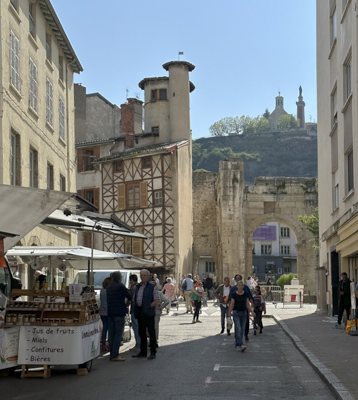
We had a delicious Armenian lunch in Vienne at Les Frangins – Specialities Armeniennes restaurant.

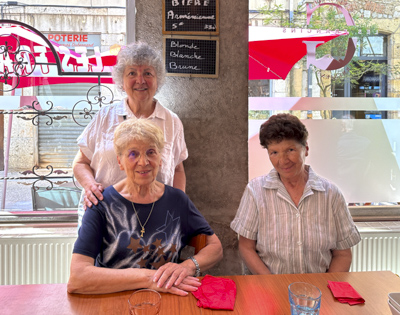
We also went to see the interior of the French Gothic Cathedral of Saint-Maurice which was constructed between 1052 and 1533.

The highest point in Vienne is Mont Pipet which dominates the landscape over the Rhone River. A chapel was built on the mountaintop in 1873 to honor Our Lady of La Salette. In front of the chapel, there’s an overlook with wonderful views of the town of Vienne and the Rhone River Valley.

Below the chapel, on the hillside of Mont Pipet, is a Roman amphitheater. The Theatre Antique de Vienne, built between 40 to 50 AD, originally housed 13,000 spectators. It was one of the largest amphitheaters in the Roman Empire. Today, the theater is used for outdoor concerts and musical events, notably the famous annual Festival Jazz A Vienne.

One afternoon, we drove into the city of Lyon to the Parc de la Tete d’or to see their magnificent rose garden. It’s a large urban park of about 290 acres and has a zoo, a botanical garden, picnic areas, and a lake for boating.


On the way home, we inadvertently ran into a huge demonstration supporting the current Turkish president’s election. Cars carrying red Turkish flags stopped and parked in busy intersections in the middle of Lyon and totally blocked traffic for some time.

Another day, we drove east toward the city of Grenoble and met my cousin, Jean-Marie, in the gorgeous village of Villard-de-Lans. It’s located in the Rhone-Alps region of France and is a popular center for skiing in the winter. The architecture of the buildings in the village and the mountains beyond reminded me of Switzerland.

We had a delicious lunch of regional pate foie gras, roasted free-range chicken and fresh organic vegetables. Mousse au chocolat and raspberry coulis (sauce) over cheese for dessert. Yum!

After lunch, we drove a short distance up a mountain road to the Memorial to the French Resistance in Vercors. The National Historic Site commemorates the place where, in July 1944, German forces surrounded and attacked the town of Valchevriere where Resistance fighters and civilians were living.

We parked the car and hiked to the tiny village. The small chapel has been restored but all the houses were in ruins.

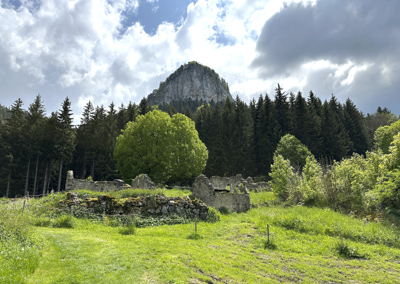
Claudine and Astrig’s cousins own and operate a commercial flower shop out of the garage at their home. We went to visit to chat and admire the beautiful flowers and their lovely arrangements.


About 30 minutes from Chasse-sur-Rhone is the Aqueduct of Gier. It’s an ancient Roman aqueduct built during the 1st century to provide water to Lugdunum, the Roman name of Lyon. It’s the longest and best preserved aqueduct in the region.

The water came from the source of the Gier River, which is a tributary of the Rhone River. When completed, the aqueduct was 53 miles long.

A wooden model of a Chorobate, similar to our modern levels, showed how they were used to measure the slant of the aqueduct during construction.

One day, we drove about 2 hours from Chasse-sur-Rhone to the city of Le Puy en Velay. The word “puy” means a volcanic hill. Many tall isolated hills jutting up from the surrounding farmland were visible from the highway.
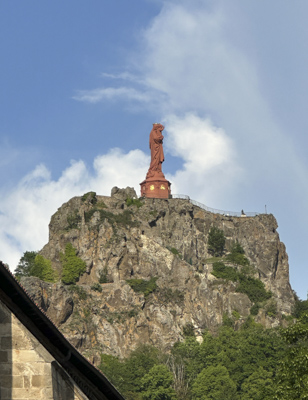
The Chapel of Saint Michael of the Needle was constructed on top of the tallest hill in 951 AD. There are 268 steps carved into the rock base to reach the chapel, so we did not attempt to climb them.

We parked the car and walked through the narrow medieval streets of the “Old Town” of Le Puy. The city is known as a center for lace-making and is also famous for green lentils grown in the area. Le Puy is a UNESCO Heritage Site because it’s one of the main starting points on the pilgrimage route of Santiago de Compostela in Spain.
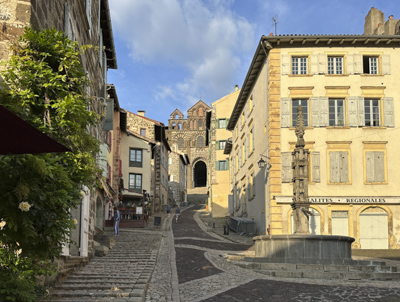

We walked up a steep hill and climbed steps up to the 12th century Cathedrale Notre Dame. It was fun to explore the maze of small streets flanked by tall brightly colored buildings in the old medieval part of the city.

On another day, we went to the Museum of the Confluences which is located at the junction of the Rhone and Saone Rivers in Lyon. It opened in 2014 and is a science and anthropology museum.

The museum is said to resemble a “floating crystal cloud of stainless steel and glass”. It was a wonderful museum to visit! There were breathtaking views from the upper floors and excellent exhibits.

There was an excellent temporary exhibition of photographs by Marc Riboud, a French photo- journalist who was born near Lyon in 1923.

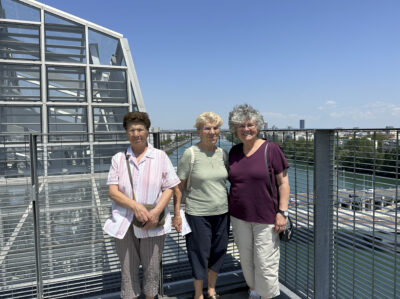
The area surrounding Lyon is the famous “Cote du Rhone” wine region. It was very interesting to drive along the eastern side of the sloping hills high above the Rhone River to see the vineyards.
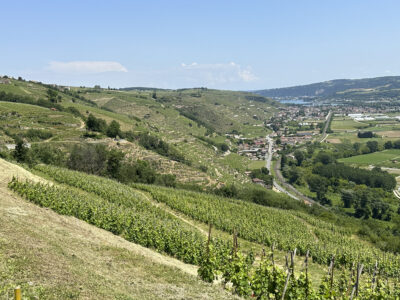

The hills are covered with vineyards – every square meter. There are miles and miles of famous world renowned vineyards…..
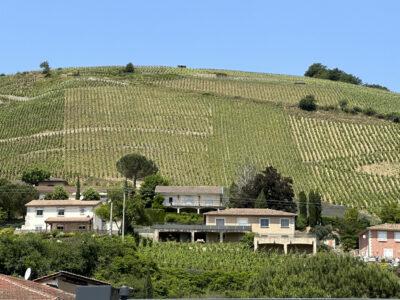
We also visited more cousins: Agnes and her family. We had a delicious Lyonnaise dinner of regional sausages and potatoes outdoors in the garden.
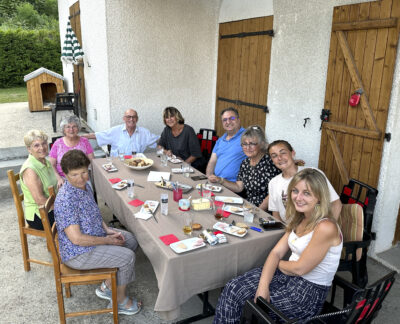
The city of Lyon is the third largest city in France after Paris and Marseille. It’s referred to as “Little Paris” because of its history, architecture, art and culture. Lyon is also the Capital of Gastronomy in the world. The Old Town of Lyon is a UNESCO World Heritage Site because of its long history which dates from Roman times.
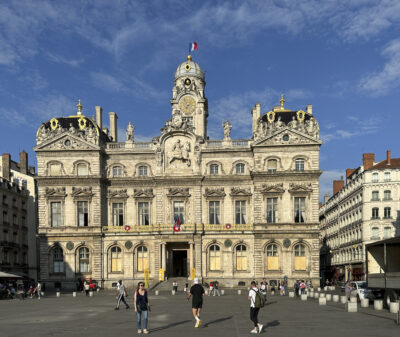
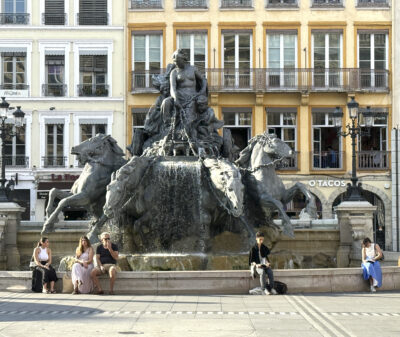
The Hotel de Ville, constructed about 1651, is located on a large busy square known as Place des Terreaux. On the other side of the square is the Fontaine Bartholdi created by Frederic Bartoldi, the sculptor of our Statue of Liberty in New York Harbor.

It was a wonderful week with my cousins Claudine and Astrig and I am grateful to be able to visit them. They are generous, loving, considerate, and kind. I am so fortunate to know them. Thank you….